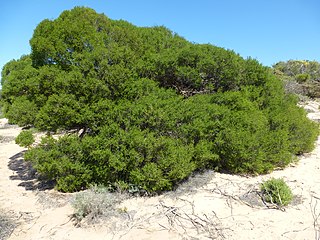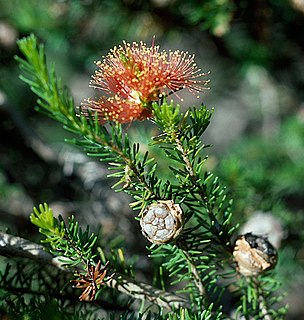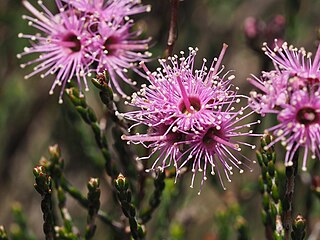
Melaleuca wilsonii, commonly known as Wilson's honey-myrtle or violet honey-myrtle, is a plant in the myrtle family, Myrtaceae, native to parts of South Australia and Victoria. It is a shrub with narrow, pointed leaves and heads of purplish-pink flowers on the sides of the branches. It is adaptable to a wide range of soils, frost hardy and often cultivated.

Melaleuca cardiophylla, commonly known as tangling melaleuca or umbrella bush is a plant in the myrtle family, Myrtaceae and is endemic to the west and south-west of Western Australia. It is a dense, prickly shrub with heart-shaped leaves, stamens that are joined in unusually long claw-like bundles, and distinctive, warty fruits.

Melaleuca eleuterostachya is a plant in the myrtle family, Myrtaceae and is endemic to Western Australia and South Australia. It is a shrub or tree with arching branches, narrow leaves and small spikes of cream or white flowers.

Melaleuca glaberrima is a plant in the myrtle family, Myrtaceae and is endemic to the south-west of Western Australia. It is a dense, spreading shrub with needle shaped, but not sharp leaves and profuse pink or mauve flowers.

Melaleuca lasiandra is a plant in the myrtle family, Myrtaceae and is native to the northern inland of Australia. Its foliage is covered with soft, silky hairs giving the leaves a silvery-grey appearance and even the filaments of the stamens are hairy.

Eremaea acutifolia, commonly known as rusty eremaea, is a plant in the myrtle family, Myrtaceae and is endemic to the south-west of Western Australia. It is a small shrub with needle-like leaves and which bears orange-coloured flowers on short side branches and fruits with a surface that is rough to the touch.

Eremaea ebracteata is a plant in the myrtle family, Myrtaceae and is endemic to the south-west of Western Australia. It is a shrub with narrow, mostly linear leaves and which bears orange-coloured flowers on the long branches of the same season's growth. The fruits have a surface that is rough and lumpy.

Beaufortia orbifolia, commonly known as Ravensthorpe bottlebrush, is a plant in the myrtle family, Myrtaceae and is endemic to the south-west of Western Australia. It is an erect or spreading shrub with round, dished leaves crowded on the younger stems, and bright red flower spikes. It is found in laterite hills near Ravensthorpe. It is distinguished from other beaufortias by having green stamen bundles with the free ends red.
Verticordia minutiflora is a flowering plant in the myrtle family, Myrtaceae and is endemic to the south-west of Western Australia. It is a bushy shrub with small, crowded, cylindrical leaves and groups of white to pale pink flowers in summer and autumn. As suggested by its botanical name, it has the smallest flowers of any verticordia.
Thryptomene biseriata is a species of flowering plant in the family Myrtaceae and is endemic to arid areas of southern central Australia. It is an erect, multi-stemmed shrub with more or less round to club-shaped leaves and pink flowers with five petals and five stamens.
Thryptomene costata is a species of flowering plant in the family Myrtaceae and is endemic to Western Australia. It is an erect shrub with upward pointing, egg-shaped leaves with the narrower end towards the base, and white or pink flowers with five petals and ten stamens.
Thryptomene caduca is a species of flowering plant in the family Myrtaceae and is endemic to a small area in the north-west of Western Australia. It is a spreading shrub with crowded egg-shaped leaves with the narrower end towards the base, and pink flowers with five petals and seven to nine stamens.
Thryptomene calcicola is a species of flowering plant in the family Myrtaceae and is endemic to a small area in the north-west of Western Australia. It is an erect, sometimes spreading shrub with upwards-pointing linear leaves, and pinkish-mauve flowers with five petals and ten stamens.
Thryptomene decussata is a species of flowering plant in the family Myrtaceae and is endemic to Western Australia. It is an erect shrub with upward pointing, egg-shaped leaves, and white or pink flowers with five petals and twenty to thirty stamens in two whorls.
Thryptomene duplicata is a species of flowering plant in the family Myrtaceae and is endemic to Western Australia. It is a spreading shrub with upward pointing, egg-shaped leaves with the narrower end towards the base, and white flowers with five petals and about fifteen stamens in two whorls.

Epacris calvertiana is a plant of the heath family, Ericaceae and is endemic to New South Wales. It is an erect to diffuse shrub with elliptic to egg-shaped leaves with a sharp-pointed tip and with white, pink or red flowers arranged along the ends of leafy branchlets.

Kunzea opposita is a plant in the myrtle family, Myrtaceae and is endemic to eastern Australia. It is a spindly shrub which has small leaves arranged in opposite pairs, and pink flowers with five petals and many stamens, the stamens much longer than the petals. It usually grows in woodland or on exposed cliffs.

Leptospermum brachyandrum is a species of shrub or small tree that is endemic to eastern Australia. It has smooth bark, linear to lance-shaped leaves and white flowers and usually grows along creeks, often in water.

Prostanthera wilkieana is a species of flowering plant that is endemic to the more arid areas of Australia. It is an erect, densely-branched shrub with elliptic to narrow egg-shaped leaves with the narrower end towards the base and mauve to pale violet or white flowers with deep purple streaks and yellowish brown dots inside the petal tube.
Elaeocarpus grahamii is a species of flowering plant in the family Elaeocarpaceae and is endemic to north-east Queensland. It is a small to medium-sized tree, sometimes coppicing, with elliptic to egg-shaped leaves, flowers with five petals that have a frilled tip, and oval blue fruit.











